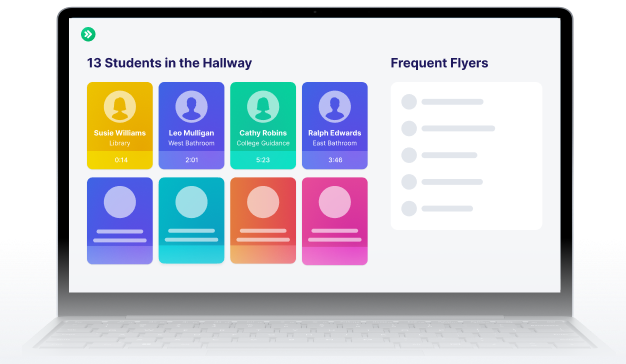In the News: Enhancing Safety in Schools Across Minnesota
Read the Story
SmartPass Co-Founders Listed on Forbes 30 Under 30
Read the Story

Lee Moskowitz
.avif)

In the modern classroom, rigid schedules often clash with dynamic student needs. While the traditional school day is broken into fixed blocks—math at 9:00, science at 10:00, lunch at noon—student support, enrichment, and intervention don’t always fit neatly into those boxes.
That’s why more schools are turning to flex periods—dedicated blocks of time in the school schedule designed to serve students in flexible, purposeful ways. And at the forefront of helping schools make flex periods actually work? Flex from SmartPass.
Originally launched in 2023, Flex has quickly evolved into a powerful, school-wide system for organizing everything from tutoring and makeup work to clubs, college visits, and enrichment. It’s not just a tool for scheduling—it’s a system for reimagining the school day.
Flex periods (also called "Flex Blocks," "Advisory," or "Anchor Hour") are scheduled times in the school day that don’t follow the traditional subject-based structure. Instead, they are used for:
Flex periods are intentionally unstructured by default, giving schools the chance to personalize learning and respond to real-time student needs.
The idea of giving students time and choice within the school day is not new—but it's never been more urgent. As schools work to address learning loss, mental health challenges, and increased demands on staff, flex periods offer a powerful solution:
But here’s the catch: managing flex time at scale is incredibly hard. Tracking where students go, what teachers offer, and who needs what help—without the right tools—can be a logistical headache.
That’s where Flex from SmartPass comes in.
“We wanted to take something as complex as a flex period and make it easy to manage,” said Jennifer Porter, Solutions Enablement Program Manager at SmartPass. “But Flex is now so much more. It provides visibility, engagement, and accountability across the entire school day—and beyond.”
Flex allows administrators and teachers to:
From a teacher adding an impromptu English support session to an admin organizing a guest speaker from a local university, Flex brings structure to what was once chaos.
TJ Rizzo, assistant principal North Attleboro High School supports student success using “Flex Blocks,” which run daily and includes 50 to 70 activities students can choose from, including:
And it doesn’t stop there. TJ’s team also uses Flex outside of Flex Block—for things like:
“Flex has allowed us to track where students are, ensure safety, and avoid classroom overloads—all while offering meaningful, student-driven learning opportunities.”
TJ emphasizes that the data Flex provides is a game-changer.
“We use Flex reports in MTSS meetings,” TJ explained. “We can track intervention minutes, monitor student participation, and even analyze which supports are making a difference.”
For Sarah, a school leader focused on curriculum and the whole child, Flex has brought clarity, equity, and engagement.
“You only get one time to do high school—I tell students to live it fully,” she said. “Flex helps us make that a reality.”
At her school, “Anchor Hour” is a daily flex period used for:
But Sarah also pushed Flex into after-school hours.
“Whether a student is attending a chess club or cheering at a swim meet, they check in through Flex,” she said. “It’s a way to take attendance, reward participation, and build school spirit.”
She’s seen real results:
“Participation has gone up. Students feel more connected. Teachers are on board, encouraging students to get involved and check in.”
Flex also helps streamline parent conversations and behavior support.
“If a student is failing, we can say: look, they missed 26 minutes of this block and visited three places. That opens up more productive dialogue with parents.”
You don’t need a full-blown “Flex Block” to benefit from Flex.
“It’s like a secondary SIS,” TJ explained. “It gives you the tools to schedule, roster, and track without adding complexity.”
Use Flex for:
“It’s only limited by your imagination,” TJ said. “Sometimes you have to build the plane while flying it plane and create experiences—Flex helps make that possible.”
One of Flex’s most powerful features? Built-in student accountability.
Students are marked present, absent, or late at each activity. Teachers and advisors can review this data in real time. And that drives deeper conversations.
“It’s helped us in IEP tracking, parent meetings, and even disciplinary conversations,” Sarah said. “You’re not just saying ‘they’re out of class too much’—you’ve got the data to show where and when.”
And most importantly, it helps students own their choices.
“We’re seeing students manage their time more responsibly,” TJ said. “They know they’re being supported—and they want to show up.”
One of the key reasons Flex works so well is that it wasn’t built in a vacuum. It was co-designed with real educators.
“We meet monthly with TJ and Sarah,” said Elaine, Flex’s product lead at SmartPass. “We build, test, iterate—together. And we’ve visited their schools, talked with teachers and students, and shaped Flex based on real-world needs.”
That collaboration is ongoing—and the product continues to evolve.
“Flex breathes creativity into schools,” Elaine added. “It makes students excited to show up and participate. And that energy is contagious.”
Flex isn’t just a way to manage flex time—it’s a system for building stronger, more personalized school experiences.
Whether you’re launching a daily flex block or just looking for a better way to schedule enrichment and support, Flex from SmartPass gives you the tools to make flexibility practical, scalable, and impactful.
“It brings your school together in one bubble,” Sarah said. “It’s transparent. It’s empowering. And it works.”


.jpg)
